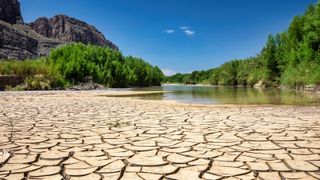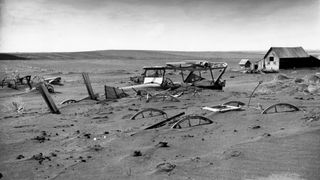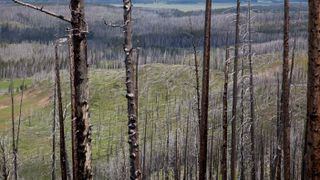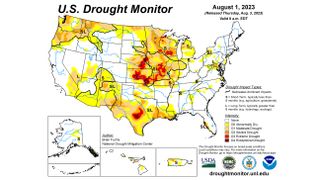The worst droughts in US history
From the Middle Ages to today, North America has experienced a number of extremely dry periods.

Dry conditions are expected to become more common across central North America and the U.S. Southwest as the planet heats up from climate change. However, periods of drought have been common throughout American history.
Medieval droughts

In 1994, Scott Stine, a professor emeritus in geography at California State University East Bay, discovered evidence of two medieval droughts that affected what is now California. Stine studied tree rings to determine that the first drought lasted 200 years before A.D. 1112, while the second endured for around 140 years before 1350. A series of megadroughts, from around 800 to 1400, also devastated the American Southwest, which scientists think was caused by a combination of factors including a rise in the sun's energy that was absorbed by Earth, a warming of the North Atlantic Ocean, as well as harsh and recurring La Niña events. These droughts likely played a part in a number of civilizations’ collapse.
16th-century megadrought

In the 16th century, a decades-long drought spread across North and Central America that may have contributed to the deaths of the first colonists at Jamestown, Virginia. A lack of resources, caused by the megadrought, may have led to the Jamestown inhabitants suffering from malnutrition from 1607 to 1624, when 43% of the colonists died, David Stahle, a professor of geosciences at the University of Arkansas, told Forbes. The megadrought, which researchers identified through the study of tree rings, may also have contributed to the disappearance of Walter Raleigh’s Roanoke Colony in North Carolina and the abandonment of the Spanish settlement of Santa Elena on Parris Island, according to Ed Cook, director of the Tree-Ring Laboratory at Columbia University’s Lamont-Doherty Earth Observatory in Palisades, New York, who identified to Forbes that these events both coincided with the drought.
The dust bowl

Also known as the "dirty thirties," the Dust Bowl from 1930 to 1936 was arguably one of the worst environmental disasters the U.S. faced in the 20th century. According to the National Drought Mitigation Center at the University of Nebraska, swathes of land over south-central America were affected by the Dust Bowl droughts and the states of Colorado, Oklahoma, Texas, Kansas and New Mexico were badly impacted. Poor soil management practices made matters worse, and the Great Plains quite literally turned to dust and blew away in enormous dust storms dubbed "dusters" or "black blizzards," according to the National Weather Service.
The dry 1950s

From 1950 to 1956, high temperatures and low rainfall plagued the Great Plains and the U.S. Southwest. In Texas, rainfall decreased by 40% between 1949 and 1951, according to the Texas Water Resources Institute (TWRI). In some places, crop yields fell by half.
The drought of the 1950s hit the rural communities of farmers in Texas particularly hard, as they could not feed their cattle. Some farmers resorted to burning the spines off of cacti in order to have something to feed their livestock. The dry conditions meant that water had to be rationed throughout the decade, and conservation efforts were put in place across 1,000 towns and cities.
Northeastern drought

Between 1962 and 1966, a widespread period of drought hit much of the northeastern U.S. This drought actually occurred in a period when temperatures were lower than average, but rainfall was also lower. With precipitation at abnormal lows, water conservation kicked into gear in New York City, journalist Robert Cantwell reported in August 1965 in Sports Illustrated magazine.
"[B]y this summer it was not surprising that a blimp bearing the ominous sign SAVE WATER was cruising over the otherwise cloudless skies about New York; that the city restaurants did not serve water unless patrons specifically asked for it; that fountains were turned off," Cantwell wrote.
Devastation in 1988

The drought of 1987 to 1989 affected 36% of the United States. Estimates for the cost of dealing with this drought were pegged at about $39 billion, according to the NCDC. The impact was worst in the northern Great Plains, though the West Coast and Northwest were also hit. The drought was accompanied by forest fires. In 1988, 793,880 acres (321,000 hectares) of Yellowstone National Park burned, prompting the first complete closure of the park in its history.
Today’s drought

The present prolonged drought in the western U.S. is “the driest 22-year period since at least [A.D.] 800,” according to a report published by Nature Climate Change in February 2022. It is categorized as a megadrought as it has lasted for more than two decades. Every state in the western United States is experiencing some degree of drought, and though conditions have improved in regions such as Kansas and southern Texas, the drought has gotten worse in others like Oklahoma, according to the U.S. Drought Monitor.
The National Weather Service’s Climate Prediction Center said that drought coverage has been steadily decreasing since October 2022 and forecast that drought will likely persist in existing areas due to above-normal temperatures.
Sign up for the Live Science daily newsletter now
Get the world’s most fascinating discoveries delivered straight to your inbox.

Stephanie Pappas is a contributing writer for Live Science, covering topics ranging from geoscience to archaeology to the human brain and behavior. She was previously a senior writer for Live Science but is now a freelancer based in Denver, Colorado, and regularly contributes to Scientific American and The Monitor, the monthly magazine of the American Psychological Association. Stephanie received a bachelor's degree in psychology from the University of South Carolina and a graduate certificate in science communication from the University of California, Santa Cruz.
- Emily StaniforthStaff Writer, All About History
